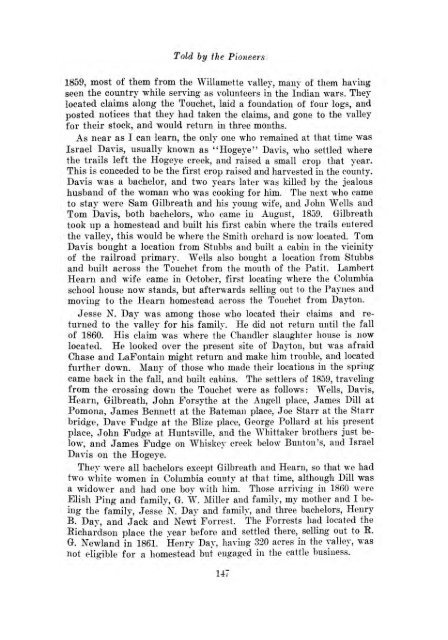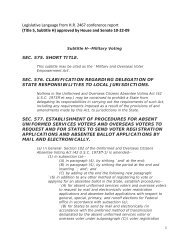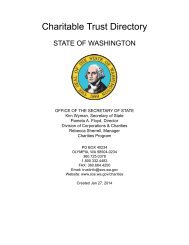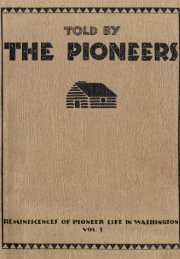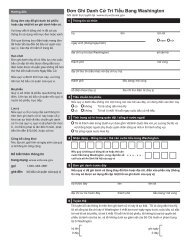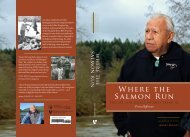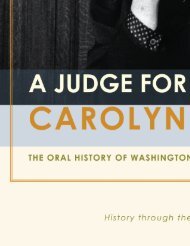Told by the Pioneers - Washington Secretary of State
Told by the Pioneers - Washington Secretary of State
Told by the Pioneers - Washington Secretary of State
Create successful ePaper yourself
Turn your PDF publications into a flip-book with our unique Google optimized e-Paper software.
<strong>Told</strong> <strong>by</strong> <strong>the</strong> <strong>Pioneers</strong><br />
1859, most <strong>of</strong> <strong>the</strong>m from <strong>the</strong> Willamette valley, many <strong>of</strong> <strong>the</strong>m ha"ing<br />
seen <strong>the</strong> country while serving as volunteers in <strong>the</strong> Indian wars. They<br />
located claims along <strong>the</strong> Touchet, laid a foundation <strong>of</strong> four logs, and<br />
posted notices that <strong>the</strong>y had taken <strong>the</strong> claims, and gone to <strong>the</strong> valley<br />
for <strong>the</strong>ir stock, and would return in three months.<br />
As near as I can learn, <strong>the</strong> only one who remained at that time was<br />
Israel Davis, usually known as "Hogeye" Davis, who settled where<br />
<strong>the</strong> trails left <strong>the</strong> Hogeye creek, and raised a small crop that year.<br />
This is conceded to be <strong>the</strong> first crop raised and harvested in <strong>the</strong> county.<br />
Davis was a bachelor, and two years later was killed <strong>by</strong> <strong>the</strong> jealous<br />
husband <strong>of</strong> <strong>the</strong> woman who was cooking for him. The next who came<br />
to stay were Sam Gilbreath and his young wife, and J oim Wells and<br />
Tom Davis, both bachelors, who came in August, 1859. Gilbreath<br />
took up a homestead and built his first cabin where <strong>the</strong> trails entered<br />
<strong>the</strong> valley, this would be where <strong>the</strong> Smith orchard is now located. Tom<br />
Davis bought a location from Stubbs and built a cabin in <strong>the</strong> vicinity<br />
<strong>of</strong> <strong>the</strong> railroad primary. Wells also bought a location from Stuhbs<br />
and built across <strong>the</strong> Touchet from <strong>the</strong> mouth <strong>of</strong> <strong>the</strong> Patit. Lambert<br />
Hearn and wife came in October, first locating- where <strong>the</strong> Columhia<br />
school house now stands, but afterwards selling out to <strong>the</strong> Paynes and<br />
mo'"ing to <strong>the</strong> Hearn homestead across <strong>the</strong> Touchet from Dayton.<br />
Jesse N. Day was among those who located <strong>the</strong>ir claims and returned<br />
to <strong>the</strong> valley for his family. He did not return until <strong>the</strong> fall<br />
• •<br />
<strong>of</strong> 1860. His claim was where <strong>the</strong> Chandler slaughter house is now<br />
located. He looked over <strong>the</strong> present site <strong>of</strong> Dayton, but 'was afraid<br />
Chase and LaFontain might return and make him trouble, and located<br />
fur<strong>the</strong>r down. Manv <strong>of</strong> those who made <strong>the</strong>ir locations in <strong>the</strong> spring<br />
•<br />
came back in <strong>the</strong> fall, and built cahins. The settlers <strong>of</strong> 1859, traveling<br />
from <strong>the</strong> crossing down <strong>the</strong> Touchet were as follows: 'Vells, Davis,<br />
Hearn, Gilbreath, John Forsy<strong>the</strong> at <strong>the</strong> Angell place, James Dill at<br />
Pomona, James Bennett at <strong>the</strong> Bateman place, Joe Starr at <strong>the</strong> Starr<br />
bridge, Dave Fudge at <strong>the</strong> Blize place, George Pollard at his present<br />
place, John Fudge at Huntsville, and <strong>the</strong> Whittaker bro<strong>the</strong>rs just below,<br />
and James Fudge on Whiskey creek below Bunton's, and Israel<br />
Davis on <strong>the</strong> Hogeye.<br />
They were all bachelors except Gilbreath and Hearn, so that we had<br />
two white women in Columbia county at that time, although Dill was<br />
a widower and had one boy with him. Those arriving in 1860 were<br />
Elish Ping and family, G. W. Miller and famil:", my mo<strong>the</strong>r and I heing<br />
<strong>the</strong> family, .resse N. Day and famil:", and three bachelors, Henry<br />
B. Day, and Jack and Newt Forrest. The Forrests had located <strong>the</strong><br />
Richardson place <strong>the</strong> year before and settled <strong>the</strong>re, selling out to R.<br />
G. Newland in 1861. Henry Day, having 320 a


